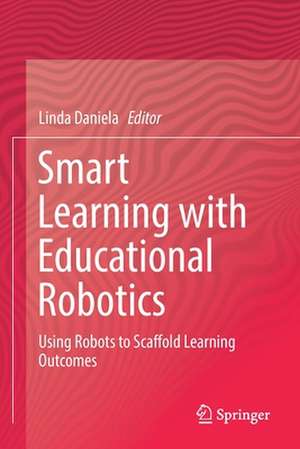Smart Learning with Educational Robotics: Using Robots to Scaffold Learning Outcomes
Editat de Linda Danielaen Limba Engleză Paperback – 14 aug 2020
| Toate formatele și edițiile | Preț | Express |
|---|---|---|
| Paperback (1) | 587.85 lei 6-8 săpt. | |
| Springer International Publishing – 14 aug 2020 | 587.85 lei 6-8 săpt. | |
| Hardback (1) | 791.09 lei 6-8 săpt. | |
| Springer International Publishing – 10 iul 2019 | 791.09 lei 6-8 săpt. |
Preț: 587.85 lei
Preț vechi: 691.59 lei
-15% Nou
Puncte Express: 882
Preț estimativ în valută:
112.49€ • 120.29$ • 93.79£
112.49€ • 120.29$ • 93.79£
Carte tipărită la comandă
Livrare economică 17 aprilie-01 mai
Preluare comenzi: 021 569.72.76
Specificații
ISBN-13: 9783030199159
ISBN-10: 3030199150
Pagini: 346
Ilustrații: XXVIII, 346 p. 142 illus., 122 illus. in color.
Dimensiuni: 155 x 235 mm
Greutate: 0.53 kg
Ediția:1st ed. 2019
Editura: Springer International Publishing
Colecția Springer
Locul publicării:Cham, Switzerland
ISBN-10: 3030199150
Pagini: 346
Ilustrații: XXVIII, 346 p. 142 illus., 122 illus. in color.
Dimensiuni: 155 x 235 mm
Greutate: 0.53 kg
Ediția:1st ed. 2019
Editura: Springer International Publishing
Colecția Springer
Locul publicării:Cham, Switzerland
Cuprins
Part I: Teaching With Robots.- Chapter 1: Opportunities And Limitations Of Robot-Teacher .- Chapter 2: What Do Teachers Believe About Using Robotics For Stem Education In Primary/Elementary Schools? Chapter 3: Curricular And Not Curricular Educational Robotics Inside And Outside The Classroom: Definitions, General Review And Some Italian Examples.- Chapter 4: Robots As Learning Agents In The Development Of Engineering Thinking.- Chapter 5: Beyond Pre-Fabricated Robots And “Black Boxes”: Introducing Maker Movement In Educational Robotics.- Chapter 6: Beyond Coding: Back To The Future With Education Robots.- Chapter 7: Future Class Teachers And Educational Robotics: Personal Attitudes, Current State And Possible Future Use.- Chapter 8: What Makes Robotics An Engaging Play? A Teacher’s Experience.- Part II: Learning With Robots: From Preschool To Tertiary Education.- Chapter 9: Programming Robots To Empower Superior Cognitive Functions In Early Childhood.- Chapter 10: Robotics In PrimarySchool: A Realistic Mathematics Approach.- Chapter 11: Design Of A Modular Robot Made With 3d Printing For Educational Purposes.- Chapter 12: Crab Robot: A Comparative Study On The Robotics Effectiveness In Discipline Of Sciences Of An Elementary School.- Chapter 13: Innovative Tools For Teaching Marine Robotics And IoT Since Primary School.- Chapter 14: Using Robots To Introduce First Year College Students To The Field Of Electrical Engineering.- Chapter 15: Designing A Competition Robot As A Capstone Project For Electrical And Computer Engineering Students.
Notă biografică
Linda Daniela is a Professor in the Faculty of Education, Psychology, and Art at the University of Latvia in Riga.
Textul de pe ultima copertă
This book will offer ideas on how robots can be used as teachers' assistants to scaffold learning outcomes, where the robot is a learning agent in self-directed learning who can contribute to the development of key competences for today's world through targeted learning - such as engineering thinking, math, physics, computational thinking, etc. starting from pre-school and continuing to a higher education level. Robotization is speeding up at the moment in a variety of dimensions, both through the automation of work, by performing intellectual duties, and by providing support for people in everyday situations. There is increasing political attention, especially in Europe, on educational systems not being able to keep up with such emerging technologies, and efforts to rectify this. This edited volume responds to this attention, and seeks to explore which pedagogical and educational concepts should be included in the learning process so that the use of robots is meaningful from the pointof view of knowledge construction, and so that it is safe from the technological and cybersecurity perspective.
Caracteristici
Compiles contemporary research on educational robotics and contextualizes it in a political and technological milieu Provides a valuable resource for all future and in-service teachers who wish to scaffold student learning by the using of robots Includes applicable best practices for using educational robotics in different educational levels and settings
